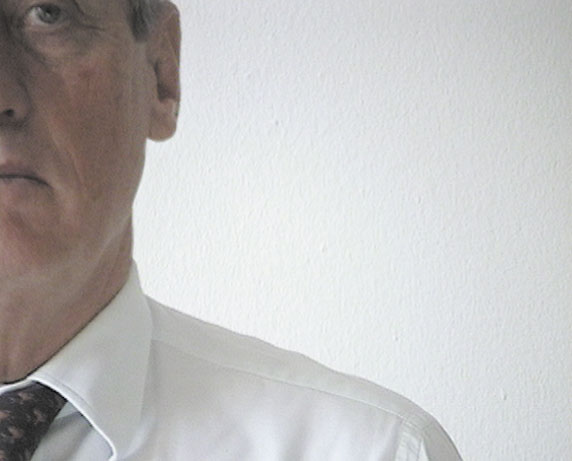CEOs
portrait subjects/participants:
Hannes Androsch, AT & S Holding, Austria
Steen Bjerre, Dyrup AS, Denmark
Ulrich H. Bode, Glaxo Wellcome, Austria
Peter Kotauczek, BEKO AG, Austria
Peter Lassen, Montana, Denmark
Anne Birgitte Lundholt, Danske Slagterier, Denmark
Martina Pecher, Inzersdorfer, Austria
Ejvind Sendal, Denmark
Jochen Werz, Lenzing AG, Austria
Norbert Zimmermann, Berndorf AG, Austria
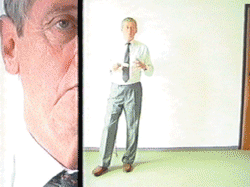
The artists thank the participants for their contribution and commitment!
CEOs is a series of video portraits that focus on an increasingly relevant and at the same time controversial power group: the executives and chairmen of corporations, companies and economic interest groups.
In his book "The Transnational Class", Leslie Sklair (1) describes a capitalist class of global players whose decisions shape and affect not only economies but also social and individual lives on a global level. However, they are often unknown, acting behind the mediated veils of private business. The public is still more familiar with policymakers in the political realm than with their counterparts in corporations, companies, interest groups and lobby agencies.
CEOs is an attempt to draw attention to decision-makers in the corporate sector. The video portrait series brings executives on the screen, instead of companies.
This affords a method that subverts corporate representation by offering what the highly mediated public image of private business excludes and eliminates: the self-representation of an individual. What emerges in these portraits are human beings with qualities and flaws, adopted behaviours and idiosyncrasies, skills and interests, awkwardness and indifference. Not unlike Western portrait art since the renaissance, CEOs depict the personality behind the insignia and gestures of power.
Adapting the coprorate interview, the artists intervene with a specific setting that allows them to sidestep the pradigmatic formats of public image mediation and control. The interview, a means to shape public opinion, is turned into a window that concentrates our attention on a human being whose powerful position in society is due to an alleged meritocracy build on skill, network, ambition and class.
There is another perspective to describe CEOs: The artists hypothesise that one can regard executive skills as proficiency in artes. In a sense, they exercise genres of art, often assisted by an armada of specialists. We can discern the arts of acting and rhetorics, the arts of choreography and rhythm, the arts of composition, colouring and sculpting, to name a few.
CEOs puts to test skills and crafts in the service of shareholder profit and value. In this view, the video art series constitutes a prototyp for the social assessment of economic leaders. Adapting a phrase from the neuroscientist Gerhard Roth (3), the portraits do not depict but deconstruct the public persona both on the individual and the organisational level.
Fernand Braudel (2) once remarked that "every dense society can be divided into different 'units': the area of the economical, of the political, the cultural and the hierarchic-societal [...] the economical can only be understood in the correlation with the other 'units, into which it disperses itself and to which at the same time it opens its gates."
The method CEOs applies in portraying business leaders corresponds as practice to Braudel's analysis. And so, the video series sheds light on a social territory that is far too neglected in relation to its connections, influence and leverage on other "units".
Gerald Nestler
(1) Leslie Sklair, The Transnational Class, Blackwell Publishers,
2001
(2) Fernand Braudel, Die Dynamik des Kapitalismus, Klett-Cotta, 1997
(3) “My case is that fundamentally brains can not reproduce the
world; they have to be constructive, namely both regarding their functional
organisation as well as regarding their function, indeed to produce a
behaviour that allows the organism to survive in its environment”,
in: Gerhard Roth, Das Gehirn und seine Wirklichkeit, Kognitive Neurobiologie
und ihre philosphischen Konsequenzen, Frankfurt am Main, 1996, p. 23
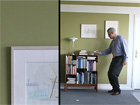
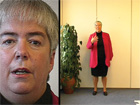
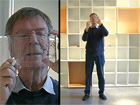
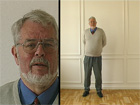
CEOs is filmed at the company headquarters. We use two cameras, one for close-up and one for total view.
Thematically, the video is divided into three parts:
The first deals with backround and socialisation, focusing on childhood and youth rather than career development.
The second is about personal relation to art. The executives perform a short piece of art of their own choice and then speak about an artwork that has had a lasting impression on them.
In the third part, the executives speak about economic, political and aesthetic issues. They are handed 13 questions of which they choose and answer 7.
The executives perform for about 30 minutes. The speech and image flow is not interrupted, which means that the footage is used in its entirety, with cuts only between the thematic parts.
CEOs artistic method is a way to queer one-dimensional corporate PR and media standards in favor of a much more complex "similitude". The subjects perform themselves and thus create their own portait, multidimensional, heterogenious, ambivalent and magnificent.
To this end, voice, facial expressions (close-up) and body gestures (total view) are equally relevent. Varying natural light is used instead of artificial lighting. Sounds enter from the outside. The dress code is informal.
